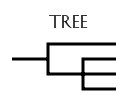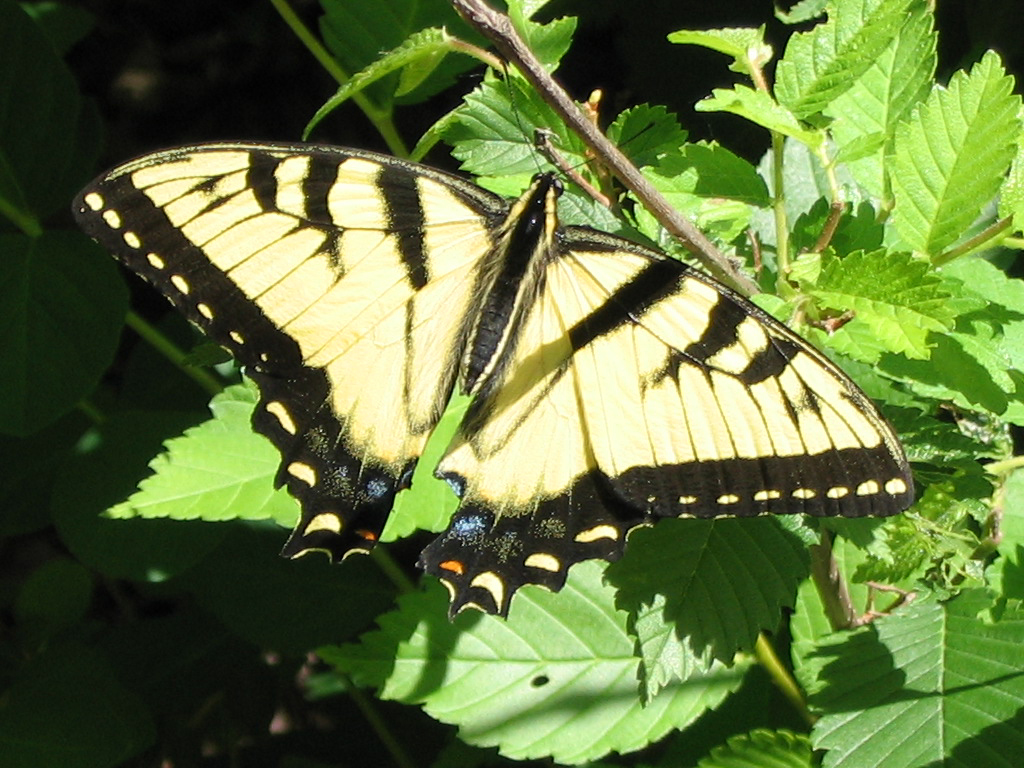| | Two-Tailed Swallowtail (Papilio multicaudata)
Chapter Outline- Description of Insecta
- Classification of Insecta
- Archaeognatha & Zygentoma
- Pterygota
- Neoptera
- Dictyoptera
- Orthoptera
- Paraneoptera
- Endopterygota
- Diptera
- Hymenoptera
- Lepidoptera and Trichoptera
- Coleoptera

Links to external sites will appear in pop-up windows. | | |
Amphiesmenoptera is a clade containing two closely-related orders: Lepidoptera and Trichoptera.
| LEPIDOPTERA - BUTTERFLIES, MOTHS | |
The order Lepidoptera contains the butterflies and moths. Butterflies tend to be diurnal (active in daylight) while moths are nocturnal (active at night). Butterflies also have clubbed antennae and lack the frenulum (a bristle that joins the two wings on each side together) that moths have. Lepidoptera is second only to the beetles (next page) as far as the number of species in an order worldwide. But, within the United States, Lepidoptera has more species observed in iNaturalist than any other, even Coleoptera. As of 2024, 10,482 species of Lepidoptera have been observed in iNaturalist in the US and 64,854 throughout the world. - SUBORDER AGLOSSATA
- SUBORDER HETEROBATHMIINA
- SUBORDER ZEUGLOPTERA
- SUBORDER GLOSSATA
- INFRAORDER DACNONYPHA
- SUPERFAMILY ERIOCRANIOIDEA
- SUPERFAMILY LOPHOCORONOIDEA
- INFRAORDER MYOGLOSSATA
- SUPERFAMILY NEOPSEUSTOIDEA
- INFRAORDER NEOLEPIDOPTERA
- PARVORDER EXOPORIA
- SUPERFAMILY HEPIALOIDEA
- SUPERFAMILY MNESARCHAEOIDEA
- PARVORDER HETERONEURA
- SUPERFAMILY ANDESIANOIDEA
- SUPERFAMILY INCURVARIOIDEA
- SUPERFAMILY NEPTICULOIDEA
- SUPERFAMILY PALAEPHATOIDEA
- DITRYSIA
- SUPERFAMILY GELECHIOIDEA
- FAMILY DEPRESSARIIDAE
- Gold-Striped Leaftier Moth (Machimia tentoriferella) - Perry Lake, KS
- SUPERFAMILY TINEOIDEA
- FAMILY PSYCHIDAE
- Bagworm - 6 (St. Louis Zoo)
- SUPERFAMILY YPONOMEUTOIDEA
- FAMILY YPONOMEUTIDAE
- Ailanthus Webworm Moth (Atteva aurea) - NOAH
- APODITRYSIA
- SUPERFAMILY CASTNIOIDEA
- SUPERFAMILY COPROMORPHOIDEA
- SUPERFAMILY COSSOIDEA
- SUPERFAMILY GALACTICOIDEA
- SUPERFAMILY IMMOIDEA
- SUPERFAMILY SCHRECKENSTEINIOIDEA
- SUPERFAMILY SESIOIDEA
- SUPERFAMILY TORTRICOIDEA
- SUPERFAMILY URODOIDEA
- SUPERFAMILY ZYGAENOIDEA
- OBTECTOMERA
- SUPERFAMILY ALUCITOIDEA
- SUPERFAMILY BOMBYCOIDEA
- FAMILY SATURNIIDAE
- Luna Moth (Actias luna) - NOAH
- Polyphemus Moth (Antheraea polyphemus) - NOAH
- African Moon Moth (Argema mimosae) - 6 (Omaha Zoo)
- Io Moth (Automeris io) - Perry Lake, KS
- Hummingbird Clearwing Moth (Hemaris thysbe) - NOAH
- FAMILY SPHINGIDAE
- Hog Sphinx (Darapsa myron) - Perry Lake, KS
- White-Lined Spjinx Moth (Hyles lineata) - 5 (Independence Rock, WY), Los Alamos, NM
- Five-Spotted Hawk Moth (Manduca quinquemaculatus) (caterpillar) - 9 (Bent's Old Fort, CO)
- SUPERFAMILY CALLIDULOIDEA
- SUPERFAMILY CIMELIOIDEA
- SUPERFAMILY DREPANOIDEA
- SUPERFAMILY EPERMENIOIDEA
- SUPERFAMILY GEOMETROIDEA
- FAMILY GEOMETRIDAE
- Chickweed Geometer (Haematopis grataria) - Perry Lake, KS
- Crocus Geometer (Xanthotype sp.) - Kansas
- SUPERFAMILY HEDYLOIDEA
- SUPERFAMILY HESPERIOIDEA
- SUPERFAMILY HYBLAEOIDEA
- SUPERFAMILY MIMALLONOIDEA
- SUPERFAMILY NOCTUOIDEA
- FAMILY EREBIDAE
- Tiger Moth - Kansas
- Forage Looper Moth (Caenurgina erechtea) - Perry Lake, KS
- Unexpected Cycnia Moth (Cycnia collaris) - Perry Lake, KS
- Salt Marsh Moth (Estigmene acrea) - Little Jerusalem Badlands, KS
- Haploa Moth (Haploa) - Perry Lake, KS
- Giant Leopard Moth (Hypercompe scribonia) (caterpillar) - Perry Lake, KS
- Painted Lichen Moth (Hypoprepia fucosa) - Perry Lake, KS
- Virginian Tiger Moth (Spilosoma virginica) - 6 (Konza)
- Tiger Moth (Spilosomina) - 6 (Konza)
- FAMILY NOCTUIDAE
- Bronzed Cutworm Moth (Nephelodes minians) - Perry Lake, KS
- Yellow-Striped Armyworm Moth (Spodoptera ornithogalli) - Greenwood County, KS
- FAMILY NOTODONTIDAE
- Drab Prominent (Misogada unicolor) - Perry Lake, KS
- SUPERFAMILY PTEROPHOROIDEA
- SUPERFAMILY PYRALOIDEA
- FAMILY CRAMBIDAE
- Carrot Seed Moth (Sitochroa palealis) - 6 (Konza)
- SUPERFAMILY URANIOIDEA
- SUPERFAMILY PAPILIONOIDEA
- FAMILY LYCAENIDAE
- Eastern Tailed-Blue (Cupido comyntas) - Perry Lake, KS
- Karner Blue Butterfly (Lycaeides melissa samuelis)
- Gray Hairstreak (Strymon melinus) - 6 (Konza)
- FAMILY NYMPHALIDAE
- Goatweed Leafwing (Anaea andria) - Perry & Kanopolis Lakes, KS
- Hackberry Emperor (Asterocampa celtis) - Perry Lake, KS
- African Monarch (Danaus chrysippus) - 6 (Omaha Zoo)
- Monarch (Danaus plexippus) - 7 (Mono Lake)
- Monarch (Danaus plexippus) (caterpillar) - 6 (Konza) - NOAH
- Julia Heliconian (Dryas iulia) - 6 (St. Louis Zoo)
- Variegated Frittliary (Euptoieta claudia) - 6 (Konza & Tallgrass Prairies)
- Starry Cracker (Hamadryas laodamia) - Peru - NOAH
- Heliconian (Heliconius sp.) - 6 (St. Louis Zoo)
- Clearwing Butterfly (Melinaea idae) - 6 (St. Louis Zoo)
- Comma Butterfly (Polygonia) - 5 (Green Wildlife Area)
- Red Admiral (Vanessa atalanta) - 6 (Wilson Lake)
- Painted Lady (Vanessa cardui) - Kansas
- FAMILY PAPILIONIDAE
- Swallowtail (Papilio sp.) - Clinton Lake - NOAH
- Eastern Giant Swallowtail (Papilio cresphontes) - Perry Lake, KS
- Eastern Tiger Swallowtail (Papilio glaucus) - Perry & Pomona Lakes, KS
- Black Swallowtail (Papilio polyxenes) - Douglas County, KS
- Spicebush Swallowtail (Papilio troilus) - Prairie Garden Trust, MO
- Cattleheart Butterfly (Parides) - 6 (St. Louis Zoo)
- FAMILY PIERIDAE
- Orange Sulfur Butterfly (Colias eurytheme) - 6 (Quivira NWR)
- Olympia Marble (Euchloe olympia) - Kanopolis Lake, KS
- Cabbage White (Pieris rapae) - Topeka Zoo
| TRICHOPTERA - CADDISFLIES | |
Trichoptera is the order of caddisflies. As of 2024, 273 species of Trichoptera have been observed in iNaturalist in the US and 791 throughout the world. - Black Dancer Caddisfly (Mystacides sepulchralis) - most iNat observations in the US for Trichoptera
- Chocolate-And-Cream Sedge (Platycentropus radiatus) - second-most iNat observations in the US for Trichoptera
| |

